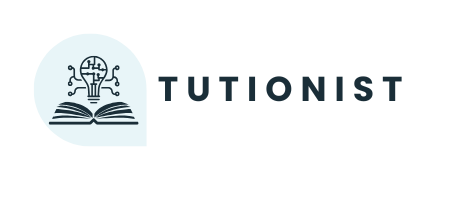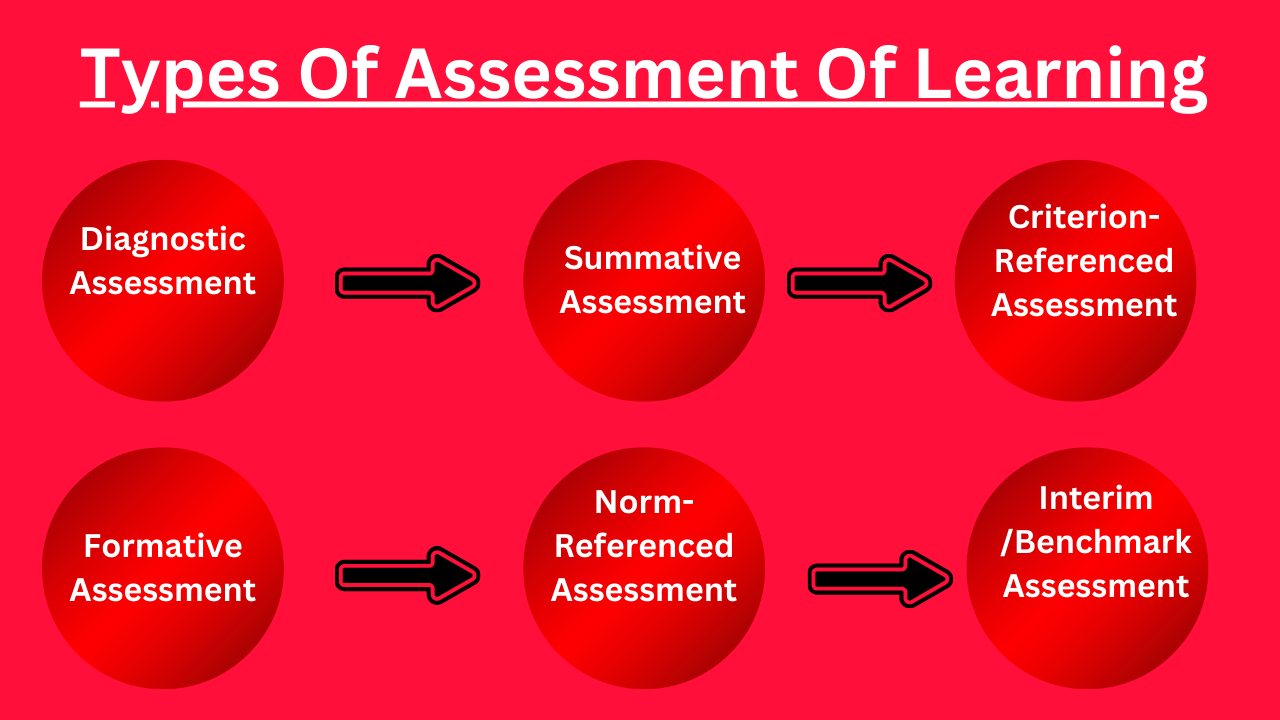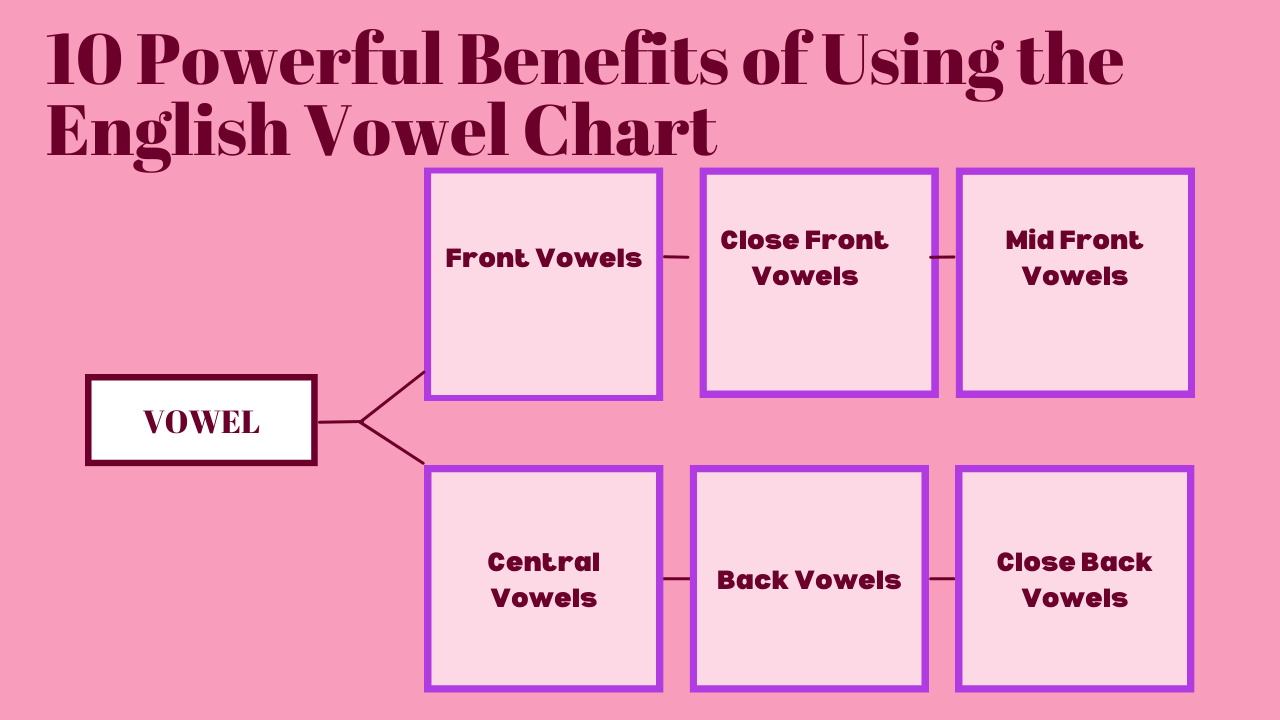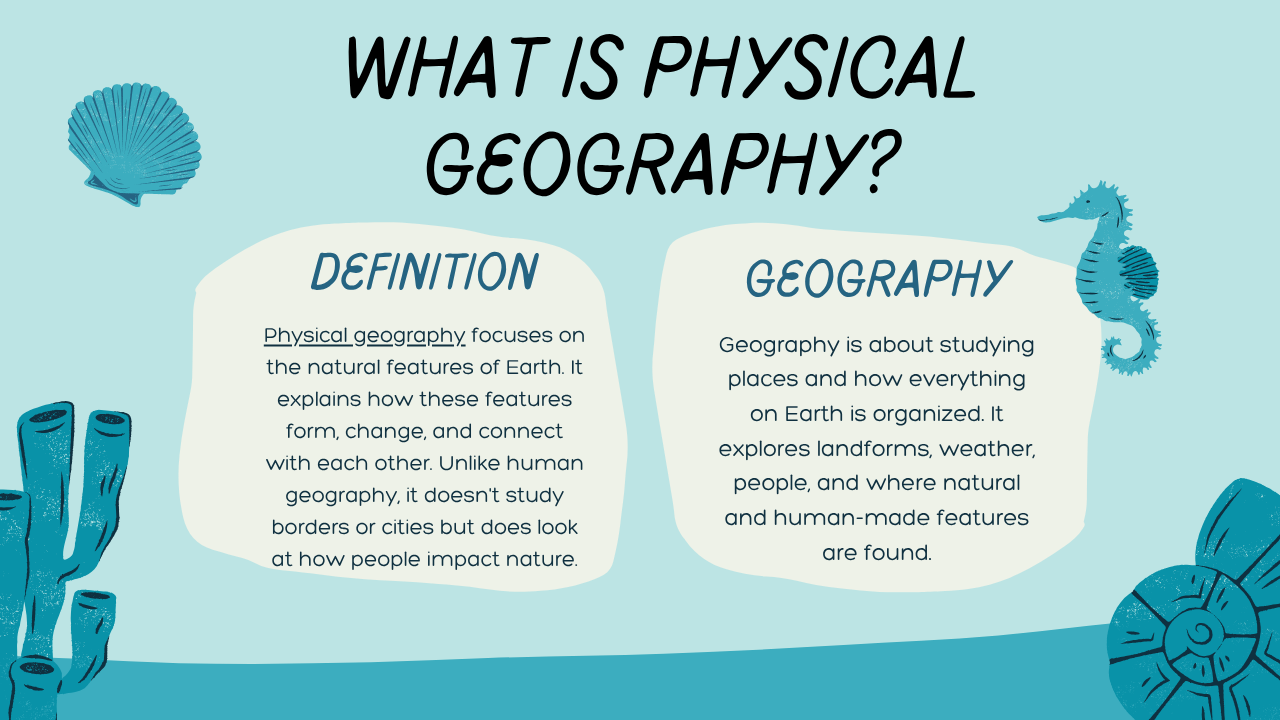Assessment of learning plays a crucial role in measuring student progress, understanding educational outcomes, and improving teaching methodologies. As educators strive to create more effective learning environments, understanding the different types of assessment of learning becomes essential for developing comprehensive evaluation strategies.
Whether you’re a classroom teacher, educational administrator, or curriculum designer, mastering these assessment types will help you make informed decisions about student progress and instructional effectiveness. This guide explores six fundamental types of assessment that every educator should understand and implement in their teaching practice.
What is Assessment of Learning?
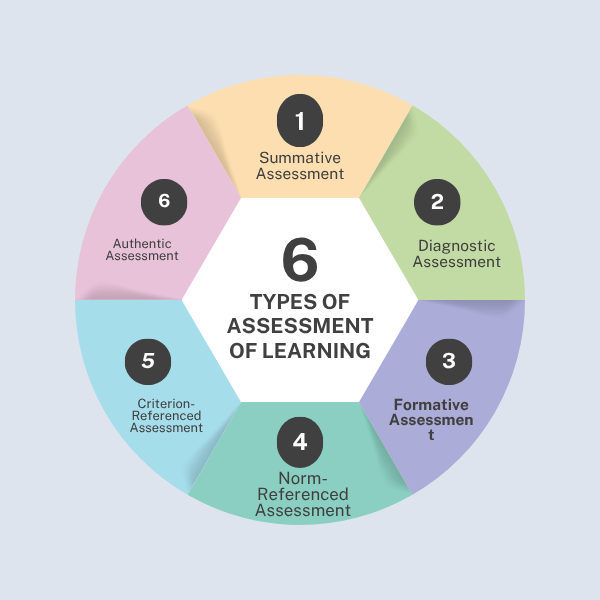
Assessment of learning refers to the systematic process of gathering, analyzing, and interpreting information about student achievement and learning outcomes. Unlike assessment for learning (formative assessment), assessment of learning typically occurs at the end of an instructional period to measure what students have accomplished.
The primary purpose of assessment of learning is to:
- Provide evidence of student achievement
- Assign grades or marks
- Report progress to stakeholders
- Make decisions about promotion or certification
- Evaluate program effectiveness
Understanding these assessment types helps educators choose the most appropriate methods for measuring student learning and ensuring educational quality.
Type 1: Summative Assessment
Summative assessment represents the most traditional form of educational assessment, occurring at the conclusion of an instructional unit, course, or academic year. This assessment type provides a comprehensive evaluation of student learning against predetermined standards or learning objectives.
Key characteristics of summative assessment:
- Conducted at the end of learning periods
- Focuses on learning outcomes and final products
- Provides definitive grades or scores
- Used for accountability and reporting purposes
- Typically high-stakes with significant consequences
Common examples include:
- Final examinations and standardized tests
- End-of-unit projects and research papers
- Comprehensive portfolios and capstone projects
- Graduation requirements and certification exams
Summative assessments are crucial for measuring overall student achievement and program effectiveness. According to the National Education Association, well-designed summative assessments provide valuable data for improving curriculum and instruction while ensuring students meet learning standards.
Best practices for summative assessment:
- Align assessments with learning objectives and standards
- Use multiple assessment formats to accommodate different learning styles
- Provide clear rubrics and scoring criteria
- Ensure reliability and validity in assessment design
- Use results to inform future instruction and curriculum development
Type 2: Diagnostic Assessment
Diagnostic assessment serves as an educational tool for identifying students’ existing knowledge, skills, and learning difficulties before instruction begins. This assessment method helps educators understand where students stand in their learning journey and what support they may need.
Purpose and benefits:
- Identifies prior knowledge and misconceptions
- Reveals learning gaps and strengths
- Informs instructional planning and differentiation
- Helps group students appropriately
- Guides resource allocation and support services
Implementation strategies:
- Pre-tests and knowledge surveys
- Skills inventories and learning style assessments
- Informal observations and conversations
- Portfolio reviews from previous coursework
- Standardized diagnostic instruments
Effective diagnostic assessment enables teachers to tailor their instruction to meet individual student needs, ultimately improving learning outcomes and student engagement.
Ready to implement effective assessment strategies in your educational practice? Discover comprehensive assessment training and resources at Tutionist.com to enhance your teaching effectiveness.
Type 3: Formative Assessment
While often confused with assessment of learning, formative assessment actually represents assessment for learning – an ongoing process that occurs during instruction to monitor student progress and adjust teaching strategies accordingly.
Distinctive features:
- Continuous and ongoing throughout instruction
- Low-stakes with minimal grade impact
- Provides immediate feedback to students and teachers
- Focuses on learning process rather than final products
- Encourages student self-reflection and metacognition
Effective formative assessment techniques:
- Exit tickets and quick polls
- Peer assessments and self-evaluations
- Think-pair-share activities
- Real-time questioning and discussions
- Learning logs and reflection journals
Research from the Assessment Reform Group demonstrates that effective formative assessment can significantly improve student achievement when implemented consistently and purposefully.
Type 4: Norm-Referenced Assessment
Norm-referenced assessment compares individual student performance to that of a larger group or population, typically called the “norm group.” This assessment approach ranks students relative to their peers rather than measuring against absolute standards.
Key characteristics:
- Compares student performance to peer groups
- Uses statistical measures like percentiles and standard scores
- Provides relative rather than absolute performance measures
- Often used for selection and placement decisions
- Helps identify high and low performers within groups
Common applications:
- Standardized achievement tests
- College entrance examinations (SAT, ACT)
- Intelligence and aptitude tests
- Competitive scholarship assessments
- Program admission requirements
Advantages and limitations: Norm-referenced assessments excel at ranking and comparing students but may not indicate whether students have mastered specific skills or knowledge. They’re particularly useful for making comparative decisions but less effective for diagnosing specific learning needs.
Type 5: Criterion-Referenced Assessment
Criterion-referenced assessment measures student performance against predetermined criteria, standards, or learning objectives rather than comparing students to each other. This approach focuses on whether students have achieved specific competencies or mastery levels.
Fundamental principles:
- Measures achievement against fixed standards
- Determines mastery of specific skills or knowledge
- Provides absolute rather than relative performance measures
- Supports standards-based education initiatives
- Enables all students to potentially achieve success
Implementation examples:
- Standards-based report cards
- Competency-based assessments
- Professional certification exams
- Driver’s license tests
- Mastery learning evaluations
Benefits for educators and students:
- Clear expectations and learning targets
- Objective measurement of skill development
- Support for differentiated instruction
- Evidence-based grading and reporting
- Alignment with curriculum standards
Criterion-referenced assessment particularly supports personalized learning approaches where students progress based on mastery rather than time spent in instruction.
Type 6: Authentic Assessment
Authentic assessment evaluates student learning through real-world, meaningful tasks that mirror the challenges and complexities students will encounter outside the classroom. This approach emphasizes practical application of knowledge and skills in realistic contexts.
Core principles:
- Reflects real-world applications and contexts
- Requires complex, higher-order thinking skills
- Involves multiple steps and extended time periods
- Allows for multiple correct approaches or solutions
- Often includes collaborative and interdisciplinary elements
Examples of authentic assessment:
- Performance-based projects and presentations
- Simulations and case study analyses
- Community-based learning projects
- Portfolio development and reflection
- Internships and work-based learning experiences
Implementation considerations:
- Develop clear rubrics that address both process and product
- Provide adequate time and resources for complex tasks
- Ensure tasks are meaningful and relevant to students
- Include opportunities for revision and improvement
- Connect assessments to real-world standards and expectations
Authentic assessment particularly benefits adult learners and students preparing for professional careers, as it bridges the gap between academic learning and practical application.
Choosing the Right Assessment Type
Selecting appropriate assessment types depends on several factors:
Learning objectives and standards: Different assessment types serve different purposes in measuring student achievement and informing instruction.
Student population and needs: Consider learner characteristics, prior knowledge, and individual learning differences when choosing assessment methods.
Available resources and time: Some assessment types require more time, technology, or specialized training than others.
Intended use of results: Determine whether results will be used for grading, placement, improvement, or accountability purposes.
Stakeholder expectations: Consider the needs of students, parents, administrators, and other stakeholders when designing assessment strategies.
Best Practices for Assessment Implementation
Ensure validity and reliability: All assessments should accurately measure what they claim to measure and produce consistent results across different contexts and times.
Provide clear criteria and expectations: Students should understand how they will be assessed and what constitutes successful performance.
Use multiple assessment methods: Combine different assessment types to gain a comprehensive understanding of student learning and accommodate diverse learning styles.
Offer timely and constructive feedback: Assessment results should inform future learning and teaching decisions rather than simply assign grades.
Maintain assessment security and integrity: Protect assessment materials and ensure fair testing conditions for all students.
Ready to transform your assessment practices with expert guidance? Visit Tutionist.com for comprehensive assessment training and professional development opportunities.
The Future of Assessment
Educational assessment continues to evolve with technological advances and changing pedagogical approaches. Emerging trends include:
- Technology-enhanced assessments with adaptive questioning
- Competency-based progression and micro-credentialing
- Artificial intelligence-powered assessment analytics
- Virtual and augmented reality assessment environments
- Blockchain-verified digital credentials and certificates
These innovations promise to make assessment more personalized, efficient, and meaningful for both educators and students.
Conclusion
Understanding the six types of assessment of learning – summative, diagnostic, formative, norm-referenced, criterion-referenced, and authentic – provides educators with a comprehensive toolkit for measuring and improving student achievement. Each assessment type serves specific purposes and offers unique benefits when implemented thoughtfully and systematically.
Effective assessment practices require careful planning, clear communication, and ongoing reflection on how assessment results can inform teaching and learning. By combining multiple assessment approaches and maintaining focus on student growth and achievement, educators can create more effective and engaging learning environments.
The key to successful assessment lies not in choosing a single “best” method, but in strategically combining different approaches to create a comprehensive assessment system that serves the needs of all learners. As education continues to evolve, staying informed about assessment best practices and emerging trends will help educators make the most of these powerful tools for improving student outcomes.
Remember that assessment should ultimately serve learning, not the other way around. When educators use assessment data to inform instruction, provide meaningful feedback, and support student growth, they create conditions for meaningful learning and lasting achievement.
Transform your educational practice with comprehensive assessment strategies and expert support from Tutionist.com – your partner in educational excellence and student success.
Frequently Asked Questions
What is the difference between assessment of learning and assessment for learning?
Assessment of learning (summative) occurs at the end of instruction to measure final achievement and assign grades, while assessment for learning (formative) happens during instruction to monitor progress and adjust teaching strategies. Assessment of learning is typically high-stakes and used for accountability, whereas assessment for learning is low-stakes and focuses on improvement.
How do I choose between norm-referenced and criterion-referenced assessment?
Choose norm-referenced assessment when you need to rank or compare students, such as for competitive selection or placement decisions. Use criterion-referenced assessment when you want to measure mastery of specific skills or standards, such as determining whether students have achieved learning objectives or are ready to progress to the next level.
What makes an assessment authentic?
Authentic assessment mirrors real-world contexts and requires students to apply knowledge and skills in meaningful, complex situations. It typically involves multiple steps, allows for various approaches, takes extended time, and connects to practical applications students might encounter outside school.
Can formative assessment be used for grading?
While formative assessment can contribute to grades, its primary purpose is to provide feedback for improvement rather than evaluation. Many educators use formative assessments for low-stakes points or participation grades, but the focus should remain on learning rather than grade accumulation.
How often should diagnostic assessment be conducted?
Diagnostic assessment should occur before beginning new units or when students demonstrate learning difficulties. It’s also valuable at the beginning of academic years, when students transition between grade levels, or when implementing new curriculum. The frequency depends on instructional needs and student population characteristics.
